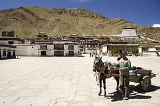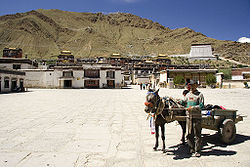
Tibetan Pony
Encyclopedia
The Tibetan pony is today found in Tibet
. Once thought to be simple hardy mountain ponies developed from Mongolian stock, recent research indicates that there may be up to six separate horse breed
s native to Tibet.
 It is generally believed that most Tibetan ponies descended from ancient stock, likely partly from the Mongolian Pony and Chinese breeds. However, some breeds, such as the Nangchen horse
It is generally believed that most Tibetan ponies descended from ancient stock, likely partly from the Mongolian Pony and Chinese breeds. However, some breeds, such as the Nangchen horse
have apparently have been bred pure for centuries. Another type, the Riwoche horse
, has been hypothesized to have been developed in isolation to a degree that some claim it is an evolutionary link between the prehistoric wild horse
and the modern domestic horse
, though it could also be a domesticated variety that reverted to primitive coloring
.
Horses in general are well regarded by the local people, and they have been traditionally kept by both wealthy Tibetans and farmers alike, as well as by the Dalai Lama
and other religious figures. The ponies were sent as gifts to Chinese Emperors, especially during the Ming
and Tang
dynasties. Horses also were commonly traded for tea from the southern parts of Sichuan province, China even as late as the 1950's. The trade was prolific to the extent that the route between Lhasa and Sichuan came to be known as the Tea-Horse Road.
Most Tibetan ponies have a pronounced jaw line, straight profile, and small ears and eyes. The neck is a muscular and a bit short, the chest is deep, the shoulder is straight. The ponies have powerful hindquarters, and short, strong legs with good joints.
Tibet
Tibet is a plateau region in Asia, north-east of the Himalayas. It is the traditional homeland of the Tibetan people as well as some other ethnic groups such as Monpas, Qiang, and Lhobas, and is now also inhabited by considerable numbers of Han and Hui people...
. Once thought to be simple hardy mountain ponies developed from Mongolian stock, recent research indicates that there may be up to six separate horse breed
Horse breed
Horse breed is a broad term with no clear consensus as to definition, but most commonly refers to selectively bred populations of domesticated horses, often with pedigrees recorded in a breed registry. However, the term is sometimes used in a very broad sense to define landrace animals, or...
s native to Tibet.
History

Nangchen horse
The Nangchen horse is a small breed of horse native to the Kham region of northern Tibet, thought to have been bred pure since the 9th century. They became known to the western world in 1994 due to the exploration of French anthropologist Michel Peissel....
have apparently have been bred pure for centuries. Another type, the Riwoche horse
Riwoche horse
The Riwoche horse is a very small horse, discovered in an isolated region of Tibet in 1995. Previously unknown to science, these small animals may be an evolutionary link between the prehistoric wild horse and the modern domestic horse, though it could also be a domesticated variety that reverted...
, has been hypothesized to have been developed in isolation to a degree that some claim it is an evolutionary link between the prehistoric wild horse
Wild Horse
The wild horse is a species of the genus Equus, which includes as subspecies the domesticated horse as well as the undomesticated Tarpan and Przewalski's Horse. The Tarpan became extinct in the 19th century, and Przewalski's Horse was saved from the brink of extinction and reintroduced...
and the modern domestic horse
Domestication of the horse
There are a number of hypotheses on many of the key issues regarding the domestication of the horse. Although horses appeared in Paleolithic cave art as early as 30,000 BCE, these were truly wild horses and were probably hunted for meat. How and when horses became domesticated is disputed...
, though it could also be a domesticated variety that reverted to primitive coloring
Primitive markings
Primitive markings among domestic horses are a group of hair coat markings and qualities associated with primitive breeds, and the dun coat color family in particular. All dun horses possess at least the dorsal stripe but the presence of the other primitive markings varies...
.
Horses in general are well regarded by the local people, and they have been traditionally kept by both wealthy Tibetans and farmers alike, as well as by the Dalai Lama
Dalai Lama
The Dalai Lama is a high lama in the Gelug or "Yellow Hat" branch of Tibetan Buddhism. The name is a combination of the Mongolian word далай meaning "Ocean" and the Tibetan word bla-ma meaning "teacher"...
and other religious figures. The ponies were sent as gifts to Chinese Emperors, especially during the Ming
Ming Dynasty
The Ming Dynasty, also Empire of the Great Ming, was the ruling dynasty of China from 1368 to 1644, following the collapse of the Mongol-led Yuan Dynasty. The Ming, "one of the greatest eras of orderly government and social stability in human history", was the last dynasty in China ruled by ethnic...
and Tang
Tang Dynasty
The Tang Dynasty was an imperial dynasty of China preceded by the Sui Dynasty and followed by the Five Dynasties and Ten Kingdoms Period. It was founded by the Li family, who seized power during the decline and collapse of the Sui Empire...
dynasties. Horses also were commonly traded for tea from the southern parts of Sichuan province, China even as late as the 1950's. The trade was prolific to the extent that the route between Lhasa and Sichuan came to be known as the Tea-Horse Road.
Characteristics
The ponies are known for having considerable strength and endurance for their size, as well as sure-footedness and resilience. They are mostly kept as light draft animals, as well as for pack and riding work. The Nangchen horse is used as a race horse and for handling livestock.Most Tibetan ponies have a pronounced jaw line, straight profile, and small ears and eyes. The neck is a muscular and a bit short, the chest is deep, the shoulder is straight. The ponies have powerful hindquarters, and short, strong legs with good joints.

